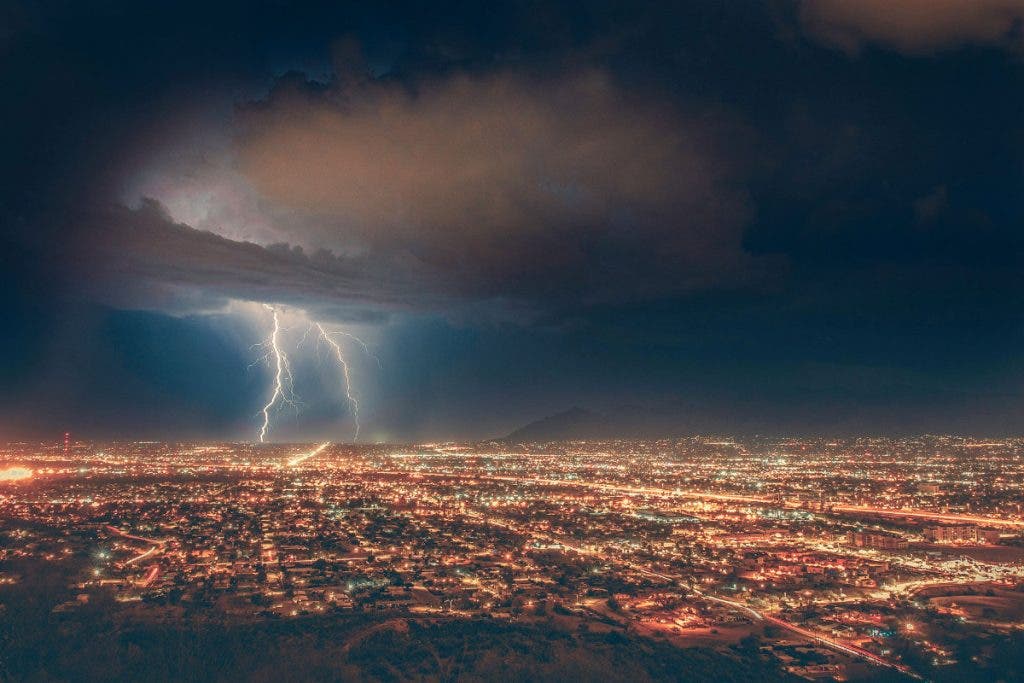As a nature photographer, weather is a big part of my planning process. That’s not to say I expect the worst or only plan a photo session if the forecast is perfect. But perfect weather comes in many different expressions. I love taking photos in stormy weather because it is unpredictable, rare, and rewarding. No two storms look alike. Although you will probably get wet or uncomfortable, you will also take amazing photos. Here is how to make the most of stormy weather in your photography.
Don’t Focus on a Moment, Focus on a Narrative
Stormy weather isn’t something that happens. It has a beginning, middle, and end. Capture that. One can easily notice how the environment is preparing for what’s coming. The sky is changing colors; the clouds are transforming as well, the sea and the forest are getting agitated. Animals look for shelter, and people secure their outdoor objects. The wind strengthens and provides outstanding opportunities for long exposures, capturing the movement.

Then comes the real storm, either rainy, snowy, or, in some cases, sandy. There may also be an electric storm full of lightning, but nothing else. Now, you can capture the intensity of the storm, the chaos on the streets, or the calmness and idleness that surrounds everything. It’s like when you hold your breath. There is pressure, but there is also stillness.

After the storm passes, the environment changes again. Sunrays break through the clouds, people and animals leave the shelter, and noises or different noises reappear. Vegetation has intense colors, maybe covered in raindrops or snowflakes. That’s a new chapter in your stormy weather photography story, the grand finale. Take notice of the fantastic timeline of stormy weather. It allows you to create interesting single photos and meaningful visual narratives.

Create Atmospheric Stormy Weather Compositions
Alongside the temporal layer, you also need a mood layer. Stormy weather may produce a wide variety of atmospheres. A rainstorm in the forest may create a dark, heavy atmosphere, while one in the fields may make a refreshing, joyful one. Blizzards may be painful but also magnificent. Look beyond the meteorological phenomenon and take a moment to find a perspective aligned with your artistic view.
For example, a street photographer may focus on how people are handling a storm in the city. They may tell a sad story about people who have troubles due to the rain or snow or a joyful story about people who enjoy the rain or snow. They may focus on wet shoes, frozen hands, or yellow umbrellas dancing around the city.

Stormy weather may be a subject matter in itself, particularly for nature and landscape photographers. At the same time, it may be the background of a different subject matter, such as architecture, a fashion editorial, or a commercial, in which case it adds drama and boosts energy. Stormy weather may also be a secondary subject matter and act as a conversation partner. For example, when you focus on how animals or humans interact with the storm, you create a dialog between them that becomes the main focal point of your compositions.

Based on the mood you decide on, choose an aesthetic. The black-and-white aesthetic is more dramatic, emphasizes contrasts, and creates more graphical compositions. The color aesthetic is more realistic, emphasizes the beauty of nature, and invites connection.
Embrace Minimalist Compositions
Stormy weather may be busy and crowded by visual elements such as lines, shapes, and colors as a background for another subject matter or by itself. The best thing you can do is simplify your compositions.

Use analogous colors to create mood and reduce color contrast that may aggravate the busyness of the frame. If color contrast is essential for your story, reduce the dimension of the contrasting object to balance the composition (e.g., a small red scarf on a big dark blue sky).
Also, pay attention to leading lines and shapes. Clouds have recognizable shapes that become visually heavy elements. Buildings and trees, on the other hand, create strong verticals. A clash of lines and shapes may confuse and tire the viewer. Use wide angles to tone down the clouds, for example, and close-ups to tone down the vertical lines. Try different angles and camera positions until you are satisfied with the result.
Negative space is also crucial. Leave as much as possible to make your subjects stand out and create an appealing balance between the intensity of the storm and the rest of the frame.
Camera Settings for Stormy Weather Photography
You need to be fast and efficient when taking photos in stormy weather. That’s not to say all you need are the camera’s automatic settings. Most of the time, you’ll need to take control of your camera because it can’t deal with rain, snow, lightning, and heavy wind and provides average settings that ruin your photos.
Shutter Speed
You need a fast shutter speed to freeze motion and capture falling raindrops or snowflakes. The same applies when the wind moves things around, and you don’t want a blurred effect. It also helps to use wide-angle lenses and focus at a distance.
However, you need to slow down the shutter speed to capture a flow of individual specks. Longer exposures help you create a smooth effect from cloud movement, fog, rain, and snow curtains. Make sure you bring a tripod for this. Telephoto lenses may help here by bringing closer faraway objects, smoothing edges, and creating a narrow depth of field and bokeh effect.

Most photographers use time-lapse to capture lightning because you can’t predict them. Install the camera on a tripod and set an interval for shooting between 1 and 2 seconds. Adjust camera settings to meet available light (the settings differ from daylight to night). A slower shutter speed is usually better because the strikes become more visible. However, a shutter speed that is too slow may wash out the lightning, losing its colors and details.
Aperture
Large apertures are often used to capture stormy weather because, in such conditions, there is usually less light than in clear weather. Large apertures allow more light to enter the camera and give you more flexible options for shutter speed and ISO. However, large apertures produce a narrow depth of field. If you aim for a wide depth of field (e.g., a cityscape), reduce the aperture and control exposure from shutter speed and ISO.
As a rule, start with a medium aperture (e.g., f/8) and increase or decrease it according to your artistic vision and photo setup.
ISO
If you need to sacrifice something, let it be the ISO. In most of the stormy photos I have taken, the ISO has been between ISO 400 and up to ISO 1600. Modern-day cameras and software are great at handling high ISO values. However, you need to, of course, consider the capability of your camera. If you keep the ISO low, you may not be able to freeze raindrops or waves clashing against a pier. However, photographing a snowstorm may not require such a high ISO value because the snow provides lots of light.
Gear for Stormy Weather Photography
Tripods
Although you may consider tripods clumsy or a hassle to carry around, a tripod is your best friend when photographing in strong winds.
Look for a solid build, good grip on any surface, and a center column with a hook that allows you to attach a heavy bag to it and stabilize it against the wind.
Hand-holding a telephoto lens during a storm is doable if you can lean against a building, but you will get more keeper shots to bring home if you use a sturdy tripod. Of course, a tripod is a must for capturing thunderstorms with lightning.
Protective Gear
Take care of your gear. It helps prolong the life of your camera and lenses and protects them from rain, snow, wind, sun, dust, and dirt.
There is no need to worry about your expensive lens when a simple UV filter can protect the front of the lens. It protects the lens against sand and dust but also reduces the chances of water getting to the lens. Furthermore, in case something hits the lens (e.g., hail), chances are the UV filter gets the shock and breaks and the lens remains intact.
Your kit should also include a rain cover. Think Tank is a good example. It protects your camera and lens from heavy rain while allowing you to see the camera’s LCD and controls. You can still mount your camera on the tripod, and the cover compresses to a small package when not in use.
Conclusion
Photographing stormy weather is challenging and beautiful from many points of view, from technical issues to composition opportunities to stylistic perspectives. It provides unique shots, but you need the skills to capture them. However, taking amazing photos in stormy weather will become second nature with practice. Remember to keep yourself and the camera safe!






